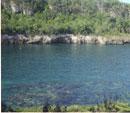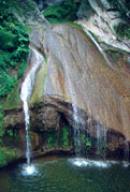Topes de Collantes
Mother Nature turned Topes de Collantes into an earthly version of Eden. Located in the vicinity of Trinidad (13 miles) and over 800 yards above sea level, this Natural Park boasts a breathtaking beauty marked by pinewoods, tree-size ferns, wild orchids, waterfalls and a whole lot more.
The high level of endemism and the perfect balance between the flora and the wildlife are key elements in the natural scenery of Topes de Collantes, in Cuba's central province of Sancti Spiritus.
All the splendor of south central Cuba is centered around the Guamuhaya Mountain Range, the aboriginal term that the island's first dwellers used to call the Escambray Sierra. That's one of Cuba's four biggest mountain ridges, declared a Protected Natural Landscape by UNESCO.
This mountainous region is characterized by steep peaks and deep in-between valleys, lavish vegetation, scores of endemic flora and wildlife species, waterfalls, natural ponds, cave systems and natural trails that allow visitors to traipse in awe around this spectacular neck of the woods.
The healthy, pure and isolated environment far from any sign of civilization, coupled with superb weather conditions –featuring environmental wellbeing parameters above 60 percent- make Topes de Collantes an ideal location for relaxation and rehab treatments. As a matter of fact, the National Rehabilitation Center, whose treatments are based on traditional medicine and therapeutic physical exercises, is perched atop those marvelous mountains.
The institution is outfitted with state-of-the-art rehabilitation equipment, a weatherized swimming pool, steam baths, sauna and a highly qualified staff in charge of providing medical treatments. However, there's no doubt in anyone's mind that the biggest health restoration effect is the possibility of living nature at its best in a sound microclimate.
In Topes de Collantes, natural conditions are simply exceptional. In addition to that, the practice of trekking, birdwatching, cave exploration and other activities are at the fingertips of nature enthusiasts.
Make no mistakes about it; this is a travel destination with a seal of its own, closely linked to the environment, and in which preservation and proper balance between nature and development are the name of the game.
The paradise-like natural scenery is complemented by the existence of over fifteen pinewood species, a dozen birches, more than a hundred ornamental plants, and a considerable assortment of ferns, medicinal plants, wild orchids, plus such trees as mahogany, poplar, cedar and magnolia.
This is also the natural haven of lots of local species like the Cuban frog, one of the world's tiniest toads. Furthermore, this one-of-a-kind topography carpeted by varied vegetation receives the positive influence of the so-called “ecological edge,” a condition that increases the presence of parrots, blackbirds, hawks, woodpeckers and tocororos (Cuba's national bird), as well as quails, ringdoves and pigeons.
In a practical way, this region operates like a natural wildlife reserve. Its distinctive features play a significant role in the breeding and protection of Cuba's animal species.
The list of endemic birds registered in the Topes de Collantes-Caburni-Potrerillo area is long, yet some species worth mentioning are the ordinary and green woodpeckers, the long-tail hawk, the thrush, the hummingbird, the mockingbird, the spotted owl, the finch, the jackdaw and the Cuban pheasant.
In the same breath, such subspecies as the red-tail ringdove, the sparrow hawk, the Cuban owl, the vulture, the buzzard, the cardinal, the oriole, the blue jay, the white-headed quail, the querequete and the Cuban thrush also find shelter in this region. In the realm of crawlers, the lizard, the newt, the gecko, the white chameleon and an assortment of harmless snakes –like the Santa Maria and the Magdalena- round up this unique wildlife.
Rivers up there are narrow and full of rapids, most of them creating deep valleys in between the mountains and jaw-dropping waterfalls along the way. Vegas Grandes, El Rocio and El Caburni (the latter is a National Monument) are good cases in point.
Comfortable Hotels Topes de Collantes gives travelers the privilege of being in a natural environment teeming with peerless resources worth taking a long look at. Several nature parks for recreation and adventure are welcome news for those eager to feast eyes on an overwhelming landscape where the blend of local knowledge, traditions and customs is simply awesome.
The beauty of Topes de Collantes is highlighted by a concentration of highly esthetic landscapes and the exclusiveness of a comfy hotel network made up of Los Pinos and Serrano hotels, the Kurhotel Escambray, Los Helechos Motel and Villa Caburni.
Caburni Park For those who get kicks out of spotting the most exclusive sites nature has put on the face of the earth, the Caburni Park is a highly valuable place. An amazing 65-yard-high waterfall hails visitors. Linked to legends and traditions, brimming with peculiar rocky formations and a very luring ambience, the location takes a 2,500-kilometer-long trek down a number of awe-inspiring valleys full of endemic floral and fauna species, plus steep slopes that should be clambered all the way to the top. Swinging by the waterfall is quite an adventure to remember. The crystal-clear water flowing into natural ponds from a number of nearby springs seduces visitors to take a swim next to the pinewoods, the coffee plants, the tree-size ferns and the enchanting environment.
Codina Park Approximately two miles from Topes de Collantes, the Codina Nature Park –an ideal place for trekking and ecotourism- stands majestically not far from the former Catalonian-owned coffee plantations at 600 yards above sea level. The Magic Carpet Trail is by and large one of its most sought-after attractions. During the whole stroll, visitors can gaze at wild orchids, a bamboo garden and the huge areas embracing lots of medicinal plants. Cueva del Altar (The Altar Cave) is a sort of natural watchtower carved in the rocks that overlooks the city of Trinidad, the Valley of Mills and the Ancon Peninsula.
El Cubano Park Another site that draws numerous visitors is the El Cubano Nature Park, standing more than 250 yards above sea level. Its two square kilometers abut the banks of the Guaurabo River, the same spot where Spanish conquistador Diego Velazquez founded the Village of Trinidad, and the same point where Hernan Cortez sailed off to the conquest of Mexico.
The Huellas de la Historia and Cimarrones de Javira trails provide ample knowledge about the history and traditions of local Cuban peasants, let alone give a well-documented glimpse at the life led by African slaves at the former Ingenito, one of the first sugar mills ever built in Trinidad.
Guanayara Park Just a 9-mile drive from Topes de Collantes, the Guanayara Park –known worldwide as The House of the Galician Woman- stands at 550 yards above sea level and provides some of the best emotion-packed adventures you can ever find. The merger of natural and cultural elements actually meets the eye, especially in an old-timed coffee farm where visitors can take a firsthand look at the grain drying process and learn about how these farmers live up in the mountains.
The Centinelas del Rio Melodioso Trail is right here, too. During the tour, you'll have the opportunity of finding out the many natural values of the Guanayara River. The eye-popping El Rocio (The Dew) Waterfall and El Venado (The Deer) natural pond of crystal-clear waters are two must-sees.
Caguanes Park North of the Yaguajay municipality, in the province of Sancti Spiritus, the Caguanes Nature Park comprises one of the core areas of UNESCO's Man and Biosphere Program. The surrounding wetlands gave the park the category of RAMSAR site. Caguanes is blessed with one of Cuba's largest cave systems (more than 35 caverns in all and underground galleries of up to 7 miles long). The Guayaberas marshland harbors one of the island nation's largest crane colonies.
Yaguajay Many references are made about the municipality of Yaguajay, on the northern side of the Sancti Spiritus province. Yet, none of them can hold a candle to the location's history and lovely natural landscapes. History in particular harks back to the 19th century, during the independence wars against the Spanish colonial rule, and more recently to the nationwide insurgency against the tyranny of Fulgencio Batista in the late 1950s. Larger-than-life guerrilla leader Camilo Cienfuegos set up his command post up in these mountains. A nearby museum that pays tribute to this legendary rebel fighter was named after him.
Also in Yaguajay, nature touched the surroundings with its magic wand and created the San Jose del Lago Villa, better known as the Mayajigua Lakes. This spa offers excellent springs of mineral and thermal water highly coveted by people with a laid-back attitude who like combining relaxing vacations with natural soothing treatments.
Banao Heights This valley, trapped among mountains, waterfalls and rivers, spiffs up the scenery of Banao Heights, marked by a singular relieve, dome-shaped hills and rhinestones that abound in the region. Penciled in as a classical botanical community for scholars and researchers of Cuban flora, the location shelters some 900 different species of plants and evergreens.
Ancon Peninsula Cuba's finest south-coast beaches are in the Ancon Peninsula, also in the municipality of Trinidad. The magnificent foreshore is equally blessed with great hotels fully equipped to guarantee a good rest after long hikes and adventurous trips. The area's natural charm is highlighted by gorgeous sea bottoms. Under the warm and see-through waters bathing the peninsula of Cayo Blanco, the country's largest coral reef barrier stretches out for the whole wide world to see.
The Valley of Mills West of the city of Trinidad, the Valley of Mills or the San Luis Valley –where some seventy sugar factories stood tall during the 19th century- there is now a similar number of archeological sites: ruins of the former sugar mills, old-timed plantations estates, slave barracks and lots of rudimentary artifacts from the colonial rule are still there for both foreign and local visitors to see.
One of the most spectacular constructions is the Iznaga Tower, right in the middle of the hut hamlet of Manaca Iznaga. This valley and the city of Trinidad were declared Heritage of Mankind by UNESCO back in 1988.






































































